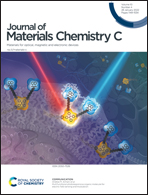Synergistic magnetic proximity and ferroelectric field effect on a 2H-VS2 monolayer by ferromagnetic termination of a BiFeO3(0001) surface†
Abstract
In the present work, the simultaneous introduction of magnetic proximity and a ferroelectric field is demonstrated to be an encouraging strategy for obtaining nonvolatile electrically-controlled 2D van der Waals ferromagnetic semiconductors. Using the carefully chosen BiFeO3(0001) surface with a Fe layer as the outmost termination, a 2H-VS2/BiFeO3(0001) archetypal system is constructed for first-principles density functional theory calculations. It is found that both the electronic and magnetic properties of the 2H-VS2 monolayer can be remarkably modulated by the synergistic effects of magnetic proximity and ferroelectric field. In particular, two types of ferromagnetic–antiferromagnetic phase transitions, which are induced by ferroelectric polarization reversal and display very different exchange interaction strength, are predicted in the 2H-VS2 overlayer depending on the interfacial magnetic configurations. The underlying magnetic proximity mechanism can be understood from the two types of spin exchange paths (V–S–Fe and V–S⋯Bi–Fe) governed by the ferroelectric field. This work opens up prospects for application of 2H-VS2/BiFeO3(0001) systems in nonvolatile nanoelectronics and spintronics devices.



 Please wait while we load your content...
Please wait while we load your content...